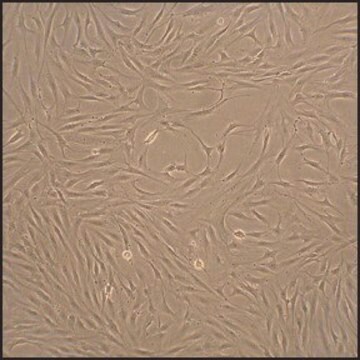408OA-05A
Human Fibroblast-Like Synoviocytes-Osteoarthritis: HFLS-OA, adult
Synonim(y):
Human fibroblast culture
About This Item
Polecane produkty
pochodzenie biologiczne
human synovial tissues (osteoarthritic)
Poziom jakości
opakowanie
pkg of 500,000 cells
producent / nazwa handlowa
Cell Applications, Inc
tryb wzrostu
Adherent
kariotyp
2n = 46
morfologia
Fibroblast-like
metody
cell culture | mammalian: suitable
powiązane choroby
arthritis; coagulation disorders
Warunki transportu
dry ice
temp. przechowywania
−196°C
Opis ogólny
HFLS-RA provide an excellent cellular model for studying synoviocyte physiology in relation to development and treatment of rheumatoid arthritis.
HFLS-RA have been used in numerous research studies to:
- Study signaling pathways implicated in the development of joint inflammation and rheumatoid arthritis (Abe, 2006; Akasaka, 2005; Bai, 2012; Fan, 2013; Furuhashi, 2008; Hashizume, 2008; Matsuyama, 2010; Tsuji, 1999; Yamaguch, 2012a,b; Yano, 2001)
- Evaluate possible contribution of EBV to nonresolving rheumatoid arthritis inflammation through inducing IL-6 production by synoviocytes (Chiu, 2013)
- Evaluate the anti-inflammatory and antirheumatic activity of various compounds, such as celastrol (Venkatesha, 2011; Xu, 2013), triptolide (Kong, 2013; Lin, 2013), arsenic trioxide (Mei, 2011), Wen Luo Yin (Liu, 2013), bucillamine (Tsuji, 2007), therapeutic lyposomes (Harigai, 2007; Ichihara, 2011; Matsumoto, 2013; Negishi, 2011), anti-IL-6R and anti-CD319 antibodies (Suzuki, 2010; Woo, 2013), as well as inhibitors of NF-κB (Baima, 2010; Keith, 2005), methionine aminopeptidase-2 (Bernier, 2004), Tpl2 (Hall, 2007), aryl hydrocarbon receptor (Lahoti, 2013) and p38 MAP kinase (Wada, 2005); and additionally demonstrate the beneficial anti-inflammatory effects of low level light therapy (Yamaura, 2009)
- Investigate the causes of metalloproteinases induction in patients with Lyme disease-associated arthritis (Lin, 2001)
- Develop adenovirus-based siRNA delivery system (Arts, 2003)
Additionally, together with normal HFLS, HFLS-RA were used to:
- Identify causing agents (such as uric acid crystals or platelet microparticles) and study the immunopathological mechanisms and signal transduction pathways leading to joint inflammation in rheumatoid arthritis (Chen, 2011a; Hsu, 2012; Mathieu, 2008; Tsuji, 2012), and to demonstrate the role of estrogen signaling in increasing inflammation (Galal, 2008)
- Investigate anti-inflammatory properties of herbal compound Sinomenine suggested for rheumatoid arthritis treatment (Chen, 2011b)
- Study the effects of extracellular matrix composition on cell attachment and migration relevant to T-cell function in inflamed tissues (Evanko, 2012)
In parallel with HFLS isolated from joints of patients with osteoarthritis HFLS-RA were used in a study demonstrating the involvement of capsid proteins of parvorvirus B19 in activating synoviocyte migration and induction of the inflammatory response leading to acute symmetrical polyarthropathy (Lu, 2006).
Finally, all three types of HFLS (normal, RA and OA) were used to investigate the role of human endogenous retroviruses (HERVs) in development of rheumatoid arthritis, and suggest that activated expression of different forms of HERV contribute to development of rheumatoid arthritis symptoms by different mechanisms (Freimanis, 2010).
Pochodzenie linii komórkowej
Zastosowanie
Komponenty
Uwaga dotycząca przygotowania
- 2nd passage, >500,000 cells in Basal Medium containing 10% FBS & 10% DMSO
- Can be cultured at least 5 doublings
Rutyna subkultury
Oświadczenie o zrzeczeniu się odpowiedzialności
Kod klasy składowania
11 - Combustible Solids
Klasa zagrożenia wodnego (WGK)
WGK 3
Temperatura zapłonu (°F)
Not applicable
Temperatura zapłonu (°C)
Not applicable
Certyfikaty analizy (CoA)
Poszukaj Certyfikaty analizy (CoA), wpisując numer partii/serii produktów. Numery serii i partii można znaleźć na etykiecie produktu po słowach „seria” lub „partia”.
Masz już ten produkt?
Dokumenty związane z niedawno zakupionymi produktami zostały zamieszczone w Bibliotece dokumentów.
Klienci oglądali również te produkty
Nasz zespół naukowców ma doświadczenie we wszystkich obszarach badań, w tym w naukach przyrodniczych, materiałoznawstwie, syntezie chemicznej, chromatografii, analityce i wielu innych dziedzinach.
Skontaktuj się z zespołem ds. pomocy technicznej









